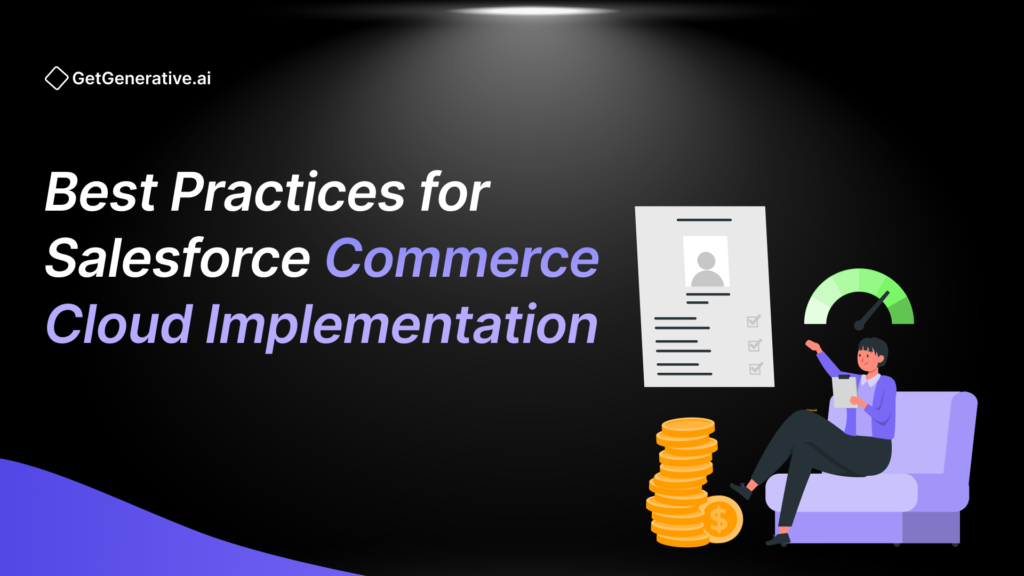Best Practices for Salesforce Commerce Cloud Implementation
Deploying Salesforce Commerce Cloud demands meticulous preparation and a well-thought-out strategy for successful execution. Below are the best practices to ensure your Salesforce Commerce Cloud implementation is successful and drives maximum ROI for your business.
1. Understand Your Business Goals
Establishing precise business objectives is a fundamental step in the implementation process. Think about your desired outcomes with Salesforce Commerce Cloud to align the platform with your organizational goals.
These goals may include enhancing customer experiences, improving operational efficiency, or scaling into new markets. Align these objectives with the platform’s capabilities, such as AI-powered personalization and omnichannel support. This ensures your implementation is purpose-driven and tailored to your specific needs.
2. Assemble the Right Team
Achieving success in Salesforce Commerce Cloud implementation significantly depends on building the right team. Involve key members from departments such as IT, sales, marketing, and customer service to ensure diverse perspectives and comprehensive insights.
Additionally, hiring experienced Salesforce professionals or partnering with certified consultants can make a significant difference. Their expertise helps in navigating technical complexities, ensuring smooth integration and configuration.
Related Read – Top Challenges in Salesforce Commerce Cloud Implementation
3. Conduct a Thorough Needs Analysis
A detailed needs analysis forms the foundation of a robust implementation plan. Audit your existing systems to determine how Salesforce Commerce Cloud will fit into your technology ecosystem. Identify potential challenges such as data migration, integration complexities, or outdated systems that need to be addressed.
This approach helps clarify the project’s scope and allocate resources effectively, ensuring streamlined execution.
4. Plan for Data Migration
Data migration remains one of the most complex aspects of implementation. Before transferring data to Salesforce Commerce Cloud, conduct a thorough cleanup to eliminate duplicates, errors, and outdated records. Use tools and methodologies that ensure seamless migration while maintaining data integrity.
Testing migrated data extensively is equally important to verify that all information has been transferred accurately and is fully functional within the new system.
5. Prioritize Scalability and Performance
It is equally critical to thoroughly test the transferred data to confirm its accuracy and functionality within the new system. Scalability and performance are essential as your business grows. Design the Salesforce Commerce Cloud infrastructure with future growth in mind, enabling it to handle increasing demands effectively.
This includes investing in robust infrastructure and leveraging cloud-based solutions to handle increasing traffic and data volumes.
Performance optimization, such as using caching mechanisms and content delivery networks (CDNs), also ensures a seamless user experience.
Also Read – Salesforce Commerce Cloud Implementation Guide 2024
6. Focus on Seamless Integration
Integrating Salesforce Commerce Cloud with existing systems is crucial for smooth operations. Identify which tools—such as ERP, CRM, and payment gateways—need to be connected and plan accordingly for a seamless workflow.
Using pre-built connectors and middleware tools like MuleSoft can simplify this process. Conducting thorough integration testing ensures that data flows smoothly across platforms without disruptions.
7. Customize Strategically
Salesforce Commerce Cloud offers extensive customization capabilities, but it’s important to avoid over-customization. Focus on customizations that are essential for your business while leveraging pre-built extensions for standard functionalities.
Over-customization can result in maintenance complications and compatibility problems during system updates. Documenting your customizations can also simplify troubleshooting and upgrades down the line.
8. Adopt Agile Methodology
Breaking down your implementation project into smaller, manageable phases allows for flexibility and continuous improvement. Using Agile methodology encourages iterative development and regular testing, enabling early identification and resolution of issues. This method also fosters stakeholder collaboration to keep the project aligned with business objectives.
9. Ensure Robust Training and User Adoption
The success of any implementation depends on how well your team adopts the new platform. Create training programs tailored to the specific needs of various user groups within your organization, from system administrators to daily users.
Interactive sessions, tutorials, and ongoing support can boost familiarity and confidence in using Salesforce Commerce Cloud. Early involvement of key personnel can promote enthusiasm and widespread adoption.
Also Read – Essential Features of Salesforce Commerce Cloud
10. Test Extensively
Testing plays a pivotal role in implementation. Conduct end-to-end testing to validate the platform’s functionality. Simulate high-traffic conditions through load testing to identify potential performance bottlenecks. Testing at each stage minimizes the risk of errors before going live.
11. Maintain Security and Compliance
Security and regulatory compliance are indispensable in today’s digital environment. Use Salesforce Commerce Cloud’s built-in security features, such as encryption and multi-factor authentication, to protect sensitive customer data.
Complying with industry standards, such as GDPR or PCI DSS, ensures data protection and helps avoid potential legal and financial risks.
12. Plan for Continuous Updates
Keeping up with Salesforce Commerce Cloud’s frequent updates and new features is essential for leveraging its capabilities. Establish a structured approach for testing updates in a staging environment before applying them to the live system to minimize disruptions. This minimizes disruptions and ensures compatibility with existing customizations.
13. Monitor and Optimize Post-Launch
Post-implementation monitoring ensures optimal platform performance. Utilize analytics tools to measure key performance metrics like user traffic, conversion rates, and engagement. Adjustments based on these insights can enhance user experience and contribute to business growth.
Conclusion
Implementing Salesforce Commerce Cloud is a significant milestone for any business, requiring detailed planning, strategic actions, and continuous refinement. When executed correctly, it can transform your e-commerce operations, elevate customer experiences, and drive sustainable growth.
With Salesforce Commerce Cloud, businesses can create exceptional e-commerce experiences, drive revenue, and achieve long-term success.
To learn more, visit GetGenerative.ai.




